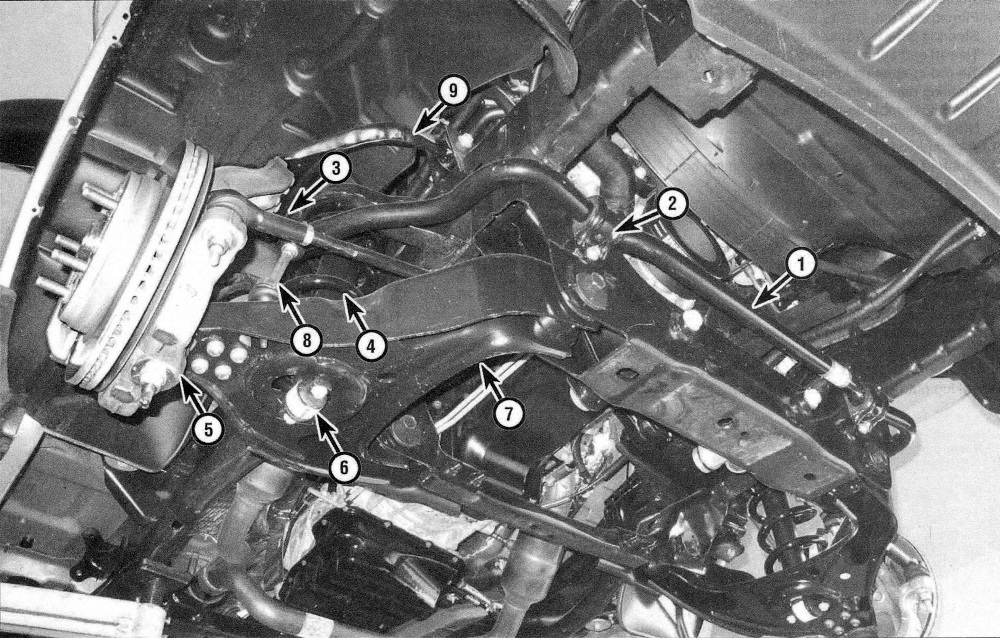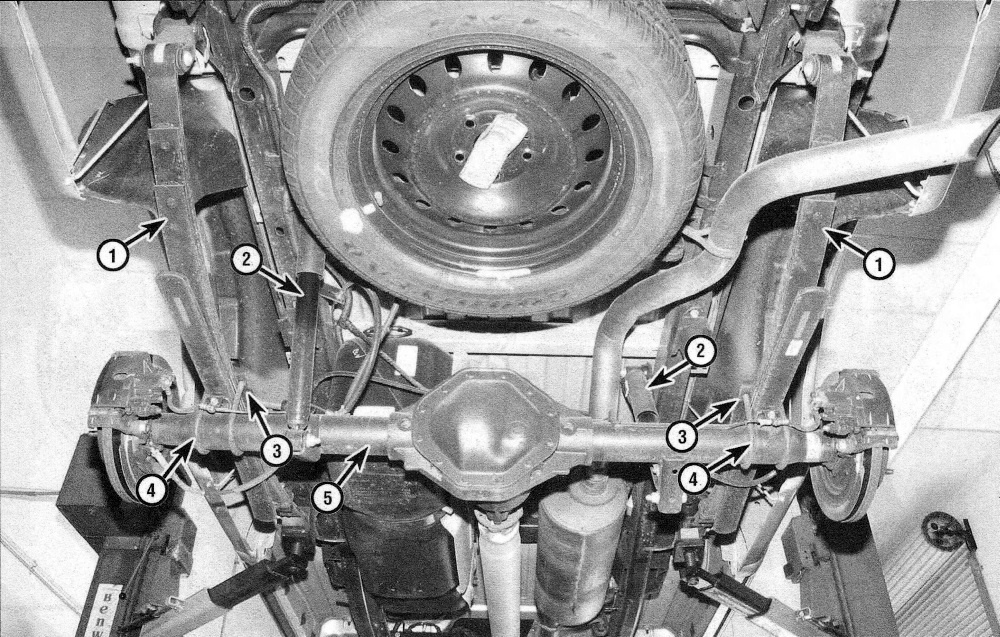Suspension and steering systems
1.1 Front suspension and steering components (2WD 1500 model)
1 Stabilizer bar
2. Stabilizer bar bushing clamps
3. Tie-rod end
4. Coil spring
5. Lower balljoint
6. Shock absorber lower mount
7. Lower control arm
8. Stabilizer bar link
9. Upper control arm
Front suspension
2WD models and are equipped with an independent front suspension system with upper and lower control arms, coil springs and shock absorbers. A stabilizer bar controls body roll. Each steering knuckle is positioned by a pair of balljoints in the ends of the upper and lower control arms (see illustration). Light-duty 4WD models are equipped with an independent front suspension system with upper and lower control arms, and coil-over shock absorbers. A stabilizer bar controls body roll. Each steering knuckle is positioned by a pair of balljoints in the ends of the upper and lower control arms. Heavy-duty 4WD models utilize a solid front axle located by a pair of longitudinal suspension arms on each side. The front axle is suspended by a pair of coil springs and shock absorbers, and located laterally by a track bar.
Rear suspension
The rear suspension on 1500 models uses coil springs, shock absorbers and four control arms. A stabilizer bar is used to control body roll and a lateral track bar keeps the rear axle centered (see illustration).
1.2 Rear suspension components (2WD 1500 model)
1. Stabilizer bar
2. Track bar
3. Shock absorber lower mount
4. Lower control arm
5. Upper control arm
6. Coil spring
The rear suspension on 2500 and 3500 models consists of two shock absorbers and two leaf springs (see illustration).
1.3 Rear suspension components (2WD)
1. Leaf springs
2. Shock absorbers
3. Spring plates
4. Spring plate U-bolts
5. Axle
Steering
The steering system on heavy-duty 4WD models consists of a recirculating-ball steering gearbox, Pitman arm, drag link, tie-rod and a steering damper. When the steering wheel is turned, the gear rotates the Pitman arm, which forces the drag link to one side. The drag link is connected to the right steering knuckle; the tie-rod is connected to the drag link and the left steering knuckle. The steering damper is attached to a bracket on the axle and to the tie-rod.
On non-heavy-duty 4WD models, the steering system consists of a rack-and-pinion steering gear and two adjustable tie-rods. All non-heavy-duty 4WD models, except 2013 and later 1500 models have hydraulic power assist steering. 2013 and later 1500 models have an Electric Power Steering (EPS) system.
.Frequently, when working on the suspension or steering system components, you may come across fasteners which seem impossible to loosen. These fasteners on the underside of the vehicle are continually subjected to water, road grime, mud, etc., and can become rusted or frozen, making them extremely difficult to remove. In order to unscrew these stubborn fasteners without damaging them (or other components), use lots of penetrating oil and allow it to soak in for a while. Using a wire brush to clean exposed threads will also ease removal of the nut or bolt and prevent damage to the threads. Sometimes a sharp blow with a hammer and punch is effective in breaking the bond between a nut and bolt threads, but care must be taken to prevent the punch from slipping off the fastener and ruining the threads. Heating the stuck fastener and surrounding area with a torch sometimes helps too, but isn’t recommended because of the obvious dangers associated with fire. Long breaker bars and extension, or cheater, pipes will increase leverage, but never use an extension pipe on a ratchet – the ratcheting mechanism could be damaged. Sometimes, turning the nut or bolt in the tightening (clockwise) direction first will help to break it loose. Fasteners that require drastic measures to unscrew should always be replaced with new ones.
Since most of the procedures that are dealt with in this Chapter involve jacking up the vehicle and working underneath it, a good pair of jackstands will be needed. A hydraulic floor jack is the preferred type of jack to lift the vehicle, and it can also be used to support certain components during various operations. Warning: Never, under any circumstances, rely on a jack to support the vehicle while working on it.
Whenever any of the suspension or steering fasteners are loosened or removed they must be inspected and, if necessary, be replaced with new ones of the same part number or of original equipment quality and design. Torque specifications must be followed for proper reassembly and component retention. Never attempt to heat or straighten any suspension or steering components. Instead, replace any bent or damaged part with a new one.


